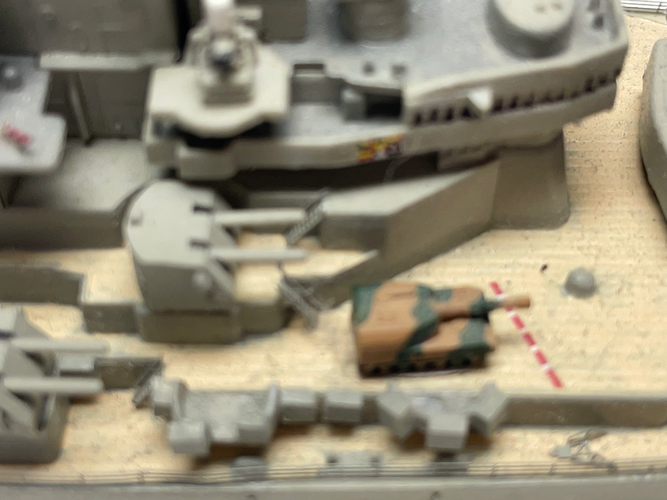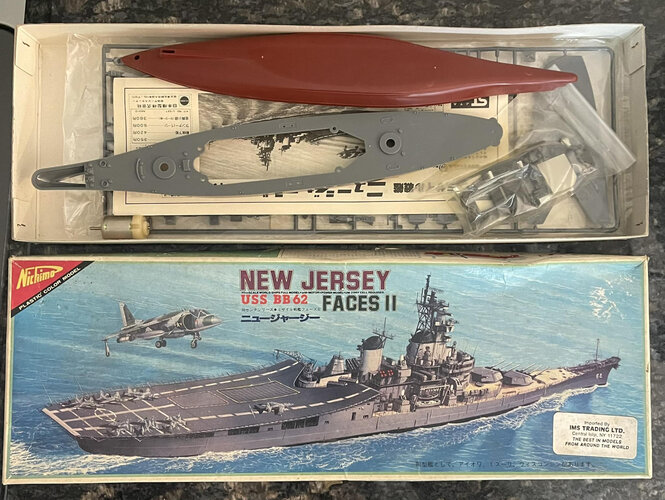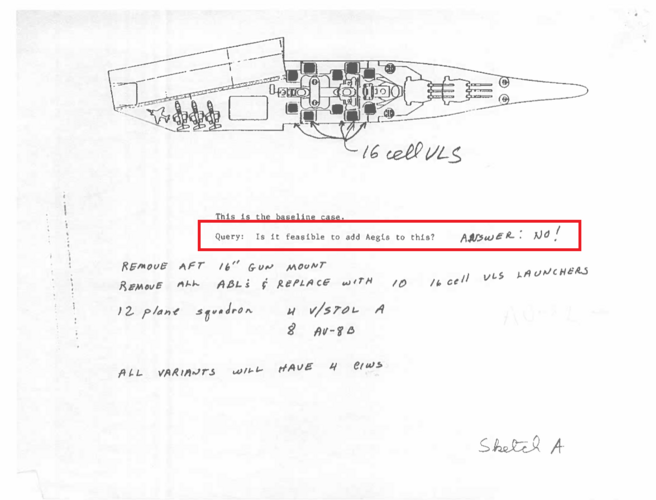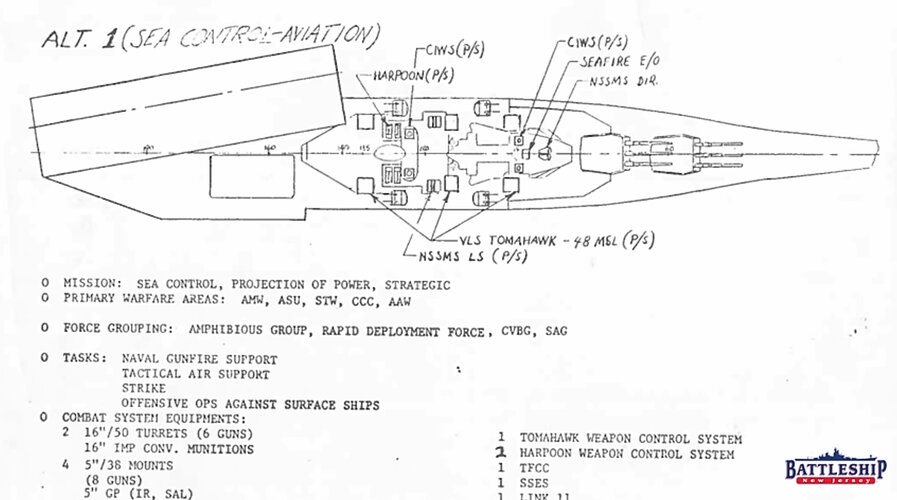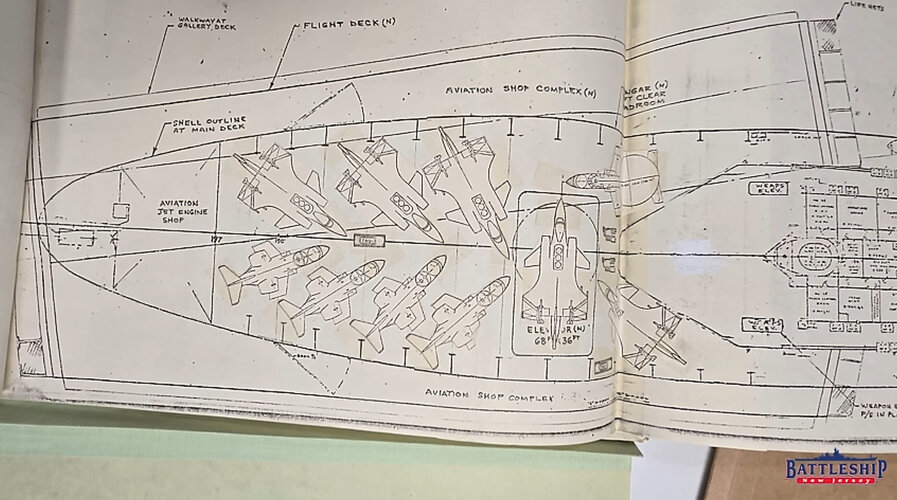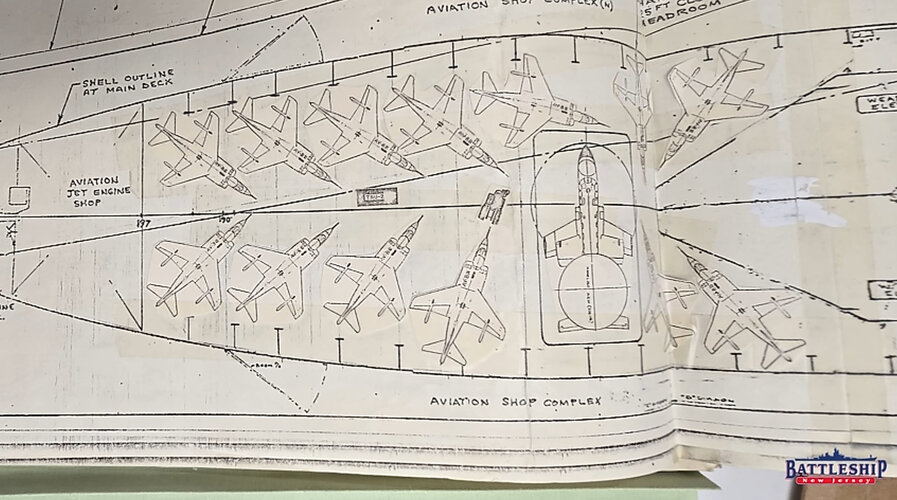I remember reading this article as a teenager thinking this would be an awesome idea. My brother, who is a retired SWO, and I were just having a conversation about the IFS concept and the USS Carronade and in my research came across this article. I would love to find a copy of the original proceedings article about this BBL concept. Is there a link or a Proceedings DBase link to it?I was debating whether this should go elsewhere, but it is vaguely related to the Iowa Phase II plans.
In November 1982, when the Iowa reactivations were just starting and the elaborate Phase II conversions still seemed possible, a naval architect by the name of Gene Anderson wrote a short article for the US Naval Institute Proceedings proposing a class of "light battleships" built around the four turrets that would be removed from the Iowas in the Phase II process. As far as I know, this was strictly a private notion, not ever seriously considered, but it's interesting to look at.
The proposed design is ~9000 tons displacement, 400 ft length (oa), 84 ft beam, 22 ft draft. Hull shape is largely inspired by contemporary merchant ships (cruise ship bow above water and bulbous bow underwater), with protection consisting of an unspecified armored box above decks around the machinery and command and control spaces and the usual torpedo blisters, voids/fuel, and a triple bottom below the water.
Propulsion would be 4-6 medium-speed diesels, for 20-25,000 bhp, giving a speed of up to 25 knots (consistent with the need to escort 20+ knot amphibs of the era).
Armament obviously gets the most attention. As described:
Sensors are mostly unmentioned, and the drawing shows a fairly basic radar fit. (Taking full advantage of the Standard Missiles in the Mk 26 would call for at least New Threat Upgrade, I would think.) There is supposedly hangar space (in the hull, I assume) for two helicopters as spotters and for other duties as required, including ASW.
- One triple 16"/50 turret, sited so it could traverse 270 degrees (blast overpressure on the superstructure would be fierce with the turret traversed fully aft...)
- Three to five Mk 45 5-inch guns, with some possibly replaced by Mk 48 8-inch guns or 155mm/50 Vertical Load Gun Mounts firing standard Army/Marine 155mm ammunition. (The drawing has three mounts that look like VLGM, which is probably the most "reasonable" choice here. Edit: Mk 48 is a mistake -- the author probably meant the Mk 71 8-inch lightweight gun.)
- Two Mk 26 launchers (which would certainly have been replaced by VLS if the design had been seriously considered)
- Two Phalanx CIWS. (As with other drawings from the era, the shape of Phalanx was not yet known, and an igloo-like structure can be seen standing in for it here).
Manning is optimistically pegged at about 100 more than an OH Perry frigate (so about 320, of which about 25-30% would be required to operate the 16-inch gun turret.)
The letters that followed this article were not kind...
I notice from that letter that there seems to have been another February 1982 article about a different (?) BB(L) concept in February 1982, but Google Books is being stubborn and won't find it for me.
You are using an out of date browser. It may not display this or other websites correctly.
You should upgrade or use an alternative browser.
You should upgrade or use an alternative browser.
Iowa and Alaska Class Conversion Projects
- Thread starter Triton
- Start date
- Joined
- 16 April 2008
- Messages
- 9,586
- Reaction score
- 14,414
I remember reading this article as a teenager thinking this would be an awesome idea. My brother, who is a retired SWO, and I were just having a conversation about the IFS concept and the USS Carronade and in my research came across this article. I would love to find a copy of the original proceedings article about this BBL concept. Is there a link or a Proceedings DBase link to it?
It's in the November 1982 Proceedings "Professional Notes"
If you have a membership, the PDF version has the actual image, which is not included in the text.
Actually I do have some in 1/700, multiple New Jerseys and somewhere in the treasure trove a box with scale Paladins. I'll see how one fits, out of curiosity.Anyone got some 1/350 scale STL files? or 1/285 we can downscale?
Gerard31956
ACCESS: Restricted
that_person
ACCESS: Secret
- Joined
- 25 May 2021
- Messages
- 334
- Reaction score
- 633
I really doubt anyone in the Navy took this seriously. My conspiracy theory is it’s something the Reagan Administration pushed.
- Joined
- 19 July 2016
- Messages
- 4,260
- Reaction score
- 3,443
I may be miossing something but, as a command system ship with modern systems they may have been very useful but, as has been pointed pointed out, very expensive and time consuming. Nuclear would have been an amazing option but where do the Buck Rogers come from?
- Joined
- 1 February 2011
- Messages
- 2,929
- Reaction score
- 3,589
It was quite serious. It was one of the Phase II proposals and New Jersey was likely to be modified to this layout.I really doubt anyone in the Navy took this seriously. My conspiracy theory is it’s something the Reagan Administration pushed.
- Joined
- 1 February 2011
- Messages
- 2,929
- Reaction score
- 3,589
I usually don't post youtube links but this video contains new information as well as original documents relating to the modernizations of the Iowas:
View: https://m.youtube.com/watch?v=UM-Or36xQHc
Christopher Wang
ACCESS: Secret
- Joined
- 3 June 2021
- Messages
- 273
- Reaction score
- 580
They were proposing to put 4x4 VLS cells in place of the 5" barbettes for a total of 10x16=160 cells as well as a rather large air group!
10:53 to 11:36
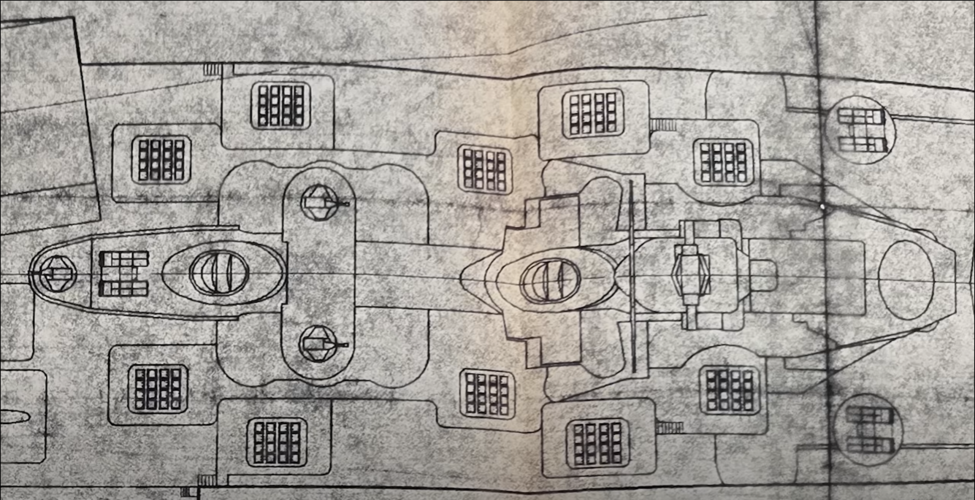
Note: Goalkeeper CIWS and RIM-7 Sea Sparrow
12:59 to 13:14
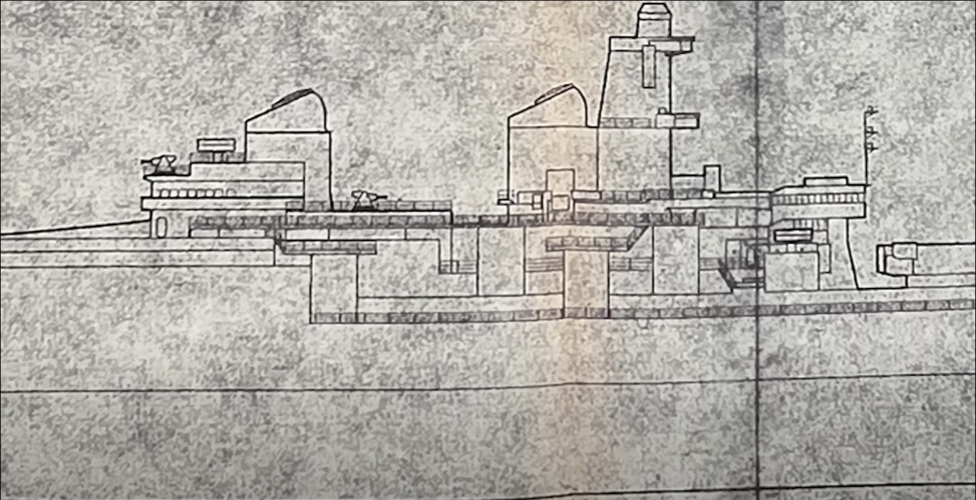
Note: As explained by museum curator Ryan Szimanski, the existing 5"/38 handling rooms were built up another two stories above their original height to make room for the Tomahawk VLS.
- Joined
- 16 April 2008
- Messages
- 9,586
- Reaction score
- 14,414

Note: Goalkeeper CIWS and RIM-7 Sea Sparrow
To be very picky, not Goalkeeper, just EX-83. The drawings suggest off-mount directors somewhere as there is no radar on the mounts themselves. There's also no evidence of directors for the Sea Sparrow.
- Joined
- 1 February 2011
- Messages
- 2,929
- Reaction score
- 3,589
Dilandu
I'm dissatisfied, which means, I exist.
The drawing might be just simplified, to reduce the number of small details that would make image hard to make out.To be very picky, not Goalkeeper, just EX-83. The drawings suggest off-mount directors somewhere as there is no radar on the mounts themselves. There's also no evidence of directors for the Sea Sparrow.
- Joined
- 16 April 2008
- Messages
- 9,586
- Reaction score
- 14,414
The drawing might be just simplified, to reduce the number of small details that would make image hard to make out.
Yeah, probably. No radars shown at all, I think.
acelanceloet
ACCESS: Confidential
- Joined
- 21 November 2012
- Messages
- 73
- Reaction score
- 74
The Goalkeeper was in service by 1981, so it is not impossible that it was an goalkeeper. That said, some of the flight deck Spruance concepts of the late 1970's (such as the Ghiradella concept and the Adams & Rains design) show EX-83 mountings without additional fire control apart from the Mk 86 GFCS. I would suspect these concepts to be more aligned to those then to the Dutch Goalkeeper
- Joined
- 16 April 2008
- Messages
- 9,586
- Reaction score
- 14,414
The Goalkeeper was in service by 1981, so it is not impossible that it was an goalkeeper. That said, some of the flight deck Spruance concepts of the late 1970's (such as the Ghiradella concept and the Adams & Rains design) show EX-83 mountings without additional fire control apart from the Mk 86 GFCS. I would suspect these concepts to be more aligned to those then to the Dutch Goalkeeper
The drawings don't include any of the radars added to the EX-83 to make it into Goalkeeper.
acelanceloet
ACCESS: Confidential
- Joined
- 21 November 2012
- Messages
- 73
- Reaction score
- 74
Yeah, exactly what I meantThe drawings don't include any of the radars added to the EX-83 to make it into Goalkeeper.
Dilandu
I'm dissatisfied, which means, I exist.
Firefinder
ACCESS: Top Secret
- Joined
- 5 October 2019
- Messages
- 1,041
- Reaction score
- 1,888
All the Aegis propolous for the Iowas that I have seen all called for the removal of the 16 inchers.
Which makes sense in multiple ways from Logi, those guns are at best 40 year old and the factory long gone, to the techical, BIG GUN MAKES BIG BOOM.
Which makes sense in multiple ways from Logi, those guns are at best 40 year old and the factory long gone, to the techical, BIG GUN MAKES BIG BOOM.
Dilandu
I'm dissatisfied, which means, I exist.
They didn't scan the "BB-61 air capable feacibility study" yet?Here is the document they scanned and shows the simplified drawings.
Dilandu
I'm dissatisfied, which means, I exist.
Oh, I'll be waiting with great anticipation!They intend to scan it but the size of it makes it difficult and as the holidays are near the avaliable people too is reduced.
Scott Kenny
ACCESS: USAP
- Joined
- 15 May 2023
- Messages
- 11,418
- Reaction score
- 13,912
And more importantly, BIG RADAR NO LIKE BIG BOOM. Big gun make big boom, big radar stop working.All the Aegis propolous for the Iowas that I have seen all called for the removal of the 16 inchers.
Which makes sense in multiple ways from Logi, those guns are at best 40 year old and the factory long gone, to the techical, BIG GUN MAKES BIG BOOM.
- Joined
- 1 February 2011
- Messages
- 2,929
- Reaction score
- 3,589
I wonder...
The failure of th Phase II modernizations (especially the 424 VLS "Fireworks" proposal) then the deactivation of all 4 Iowas with their large capacity of Tomahawks and Harpoon launchers eventually led to the development the abortive Arsenal ship concept with it similarly large VLS capacity?
The failure of th Phase II modernizations (especially the 424 VLS "Fireworks" proposal) then the deactivation of all 4 Iowas with their large capacity of Tomahawks and Harpoon launchers eventually led to the development the abortive Arsenal ship concept with it similarly large VLS capacity?
The VLS upgrades of the Spruances added a significant capability to the fleet, as well as the Ohio SSGNs. The Arsenal ship seems to have been an aberration, a concept more than a realistic design.
As for the New Jersey, I might someday use the one with the added hangar and just a couple VLS, since that seems more practical. Maybe with one of the VTOL aircraft instead of helos. But no AEGIS!
As for the New Jersey, I might someday use the one with the added hangar and just a couple VLS, since that seems more practical. Maybe with one of the VTOL aircraft instead of helos. But no AEGIS!
Dilandu
I'm dissatisfied, which means, I exist.
Not exactly, the "arsenal ship" idea was around at least since mid-1980s (and may be earlier). Basically since the USN figured out, that with programmable computers, digital datalinks and cooperative engagement capability already in development they don't need launchers and fire control to be on same ship. And since launchers were way cheaper, the idea to build a relatively cheap units with TONS of VLC but no fire control capability was obvious.I wonder...
The failure of th Phase II modernizations (especially the 424 VLS "Fireworks" proposal) then the deactivation of all 4 Iowas with their large capacity of Tomahawks and Harpoon launchers eventually led to the development the abortive Arsenal ship concept with it similarly large VLS capacity?
Dilandu
I'm dissatisfied, which means, I exist.
Well, it was rather solid for her time in 90s - when USN still have far more missiles, than deployed launchers (the current situation is opposite - the missile inventory is not sufficient to fill all those thousands of launchers on dozens of destroyers). And while Oiho SSGN was a good idea, the "underwater monitor" concept is suitable only for Tomahawks; the "proper" arsenal ship was supposed to use all kind of missiles in Navy arsenal (i.e. SAM's, anti-submarine rockets, ect.), thus being able to add more to fleet capabilities than merely a big salvo of cruise missiles.The VLS upgrades of the Spruances added a significant capability to the fleet, as well as the Ohio SSGNs. The Arsenal ship seems to have been an aberration, a concept more than a realistic design.
- Joined
- 16 December 2010
- Messages
- 3,769
- Reaction score
- 4,109
I'm not sure if this has been mentioned earlier in the thread, but there is a design sketch for converting the Alaska Class into aircraft carriers that seems to have originated around the same time as the Iowa Class conversions were proposed.
- Joined
- 3 June 2006
- Messages
- 3,094
- Reaction score
- 3,948
Another new video.New video
[...]
Link:Battleship New Jersey said:In this episode we're talking about the plans to make the battleship into an aircraft carrier and just how many planes they could put on it.
Code:
https://youtu.be/PfjgLpstXWg?si=J8KAhsOJkhMflFLQAttachments
Scott Kenny
ACCESS: USAP
- Joined
- 15 May 2023
- Messages
- 11,418
- Reaction score
- 13,912
Huh, I thought that the VSTOL A/B/C were discarded in the late 1970s, not still kicking around in 1981...
- Joined
- 16 April 2008
- Messages
- 9,586
- Reaction score
- 14,414
Huh, I thought that the VSTOL A/B/C were discarded in the late 1970s, not still kicking around in 1981...
It really only got started on the late 70s (defined c 1976) and carried on into the early 1980s.
- Joined
- 1 February 2011
- Messages
- 2,929
- Reaction score
- 3,589
I've got an answer from Ryan Szimanski:
This is interesting because I thought the first Iowa AEGIS versions was the Phase II conversions ("Fireworks" variants)
But in 1973 the system was very new. But I can see the Navy wanting the system on the water ASAP and investigating all sorts of hulls for it. (Around this time born the various proposals like the CSGN, the Long Beach CSGN Conversion and the CGN-42 the 5th Virginia etc)
We left the blueprints with someone with a big scanner who is scanning them for free on his lunch break. I hope to get them back in the next week or two but the Christmas holiday might delay him.
https://www.usni.org/magazines/proceedings/1982/may/iowa-class-needed-once-again
Have you ever heard of the 1973 and 1975 studies to add Aegis to the Iowas? I had not. It's in a paragraph about a quarter of the way down that starts with the sentence "During the next few years, as the four lowas sat lifeless at their moorings, two feasibility studies concerning possible modernization were conducted."
Ryan
This is interesting because I thought the first Iowa AEGIS versions was the Phase II conversions ("Fireworks" variants)
But in 1973 the system was very new. But I can see the Navy wanting the system on the water ASAP and investigating all sorts of hulls for it. (Around this time born the various proposals like the CSGN, the Long Beach CSGN Conversion and the CGN-42 the 5th Virginia etc)
Firefinder
ACCESS: Top Secret
- Joined
- 5 October 2019
- Messages
- 1,041
- Reaction score
- 1,888
To add on to the Aegis bit they also look at moding the Nimitz class with it as well to allow them to act as a centeral control node for the fleet.I've got an answer from Ryan Szimanski:
This is interesting because I thought the first Iowa AEGIS versions was the Phase II conversions ("Fireworks" variants)
But in 1973 the system was very new. But I can see the Navy wanting the system on the water ASAP and investigating all sorts of hulls for it. (Around this time born the various proposals like the CSGN, the Long Beach CSGN Conversion and the CGN-42 the 5th Virginia etc)
The trouble with Aegis is the significant space needed for the radars, which would have required a complete rebuild of the superstructure. I suppose studying the idea only costs some taxpayer money, even if it wasn't a reasonable concept.
And the big guns would wreak havoc with the sensitive electronics, and any exposed launchers as there would have been in the 1970s.
And the big guns would wreak havoc with the sensitive electronics, and any exposed launchers as there would have been in the 1970s.
PappyVF477
ACCESS: Restricted
- Joined
- 4 December 2020
- Messages
- 9
- Reaction score
- 12
I agree, Aegis is 100% feasible if 16" Turrets 2 and 3 are removed, however the cost is you also have to take the entire midsection of the ship down to the main deck. which effectively makes the concept of AEGIS on it a non-starter due to huge $$$ as well as HUGE balance issues induced by completely changing the in hull and on hull mass loading. Besides Co-operative Engagement capability was already being studied/developed and that would allow a Non AEGIS Battleship to "Plug in" to the AEGIS network and be controlled/operated as if it DID have AEGIS.
I do believe Turret 1, if limited to 190 degree arc forward would not appreciatively cause concussive damage to the SPY arrays like Turret 2 could. I did the math on that 25 years ago... I don't even remember the formuals needed to calculate that today!
Given we are talking about a Battleship with the primary role as VLS carrier (or VLS + Aircraft Carrier) The 16" Guns are of secondary importance. TBH, I am a huge fan of Battleships but their time has passed. Better by far to fill the forward two turret barbetts with 180VLS tubes each than keep the 16" cannons. IMHO. IF you Need Naval Fire support you want something with a longer range, SIGNIFICANTLY higher accuracy and SAFER to use for the ship. WWII 16" technology is not it!
I do believe Turret 1, if limited to 190 degree arc forward would not appreciatively cause concussive damage to the SPY arrays like Turret 2 could. I did the math on that 25 years ago... I don't even remember the formuals needed to calculate that today!
Given we are talking about a Battleship with the primary role as VLS carrier (or VLS + Aircraft Carrier) The 16" Guns are of secondary importance. TBH, I am a huge fan of Battleships but their time has passed. Better by far to fill the forward two turret barbetts with 180VLS tubes each than keep the 16" cannons. IMHO. IF you Need Naval Fire support you want something with a longer range, SIGNIFICANTLY higher accuracy and SAFER to use for the ship. WWII 16" technology is not it!
- Joined
- 1 February 2011
- Messages
- 2,929
- Reaction score
- 3,589
I think the blast issue is just a way to not install these systems on the battleships. Such blast issues was solved by before WW1 when the echleon arrangement capital ships fired their guns cross deck. Itdamaged the planking and likely to some extent the deck underneath it. So the captains were told to not use the echleon turrets for cross deck action expect at dire situations.
Eg for the Iowas whose guns were utilised only for coastal bombardment does not need to fire at extreme angles (close to the bridge) only in extreme situations where such fire deemed absolutely necessary. Reducing the firing angle would help allivate the blast issue.
Though I've yet to see a diagram showing the overpressure values at various distances and angles from the muzzle.
Eg for the Iowas whose guns were utilised only for coastal bombardment does not need to fire at extreme angles (close to the bridge) only in extreme situations where such fire deemed absolutely necessary. Reducing the firing angle would help allivate the blast issue.
Though I've yet to see a diagram showing the overpressure values at various distances and angles from the muzzle.
Dilandu
I'm dissatisfied, which means, I exist.
Similar threads
-
-
-
Postwar Royal Navy Battleships? (NOT including the Vanguard!)
- Started by Blacktail
- Replies: 81
-
-

